Your browser does not fully support modern features. Please upgrade for a smoother experience.

Submitted Successfully!
Thank you for your contribution! You can also upload a video entry or images related to this topic.
For video creation, please contact our Academic Video Service.
| Version | Summary | Created by | Modification | Content Size | Created at | Operation |
|---|---|---|---|---|---|---|
| 1 | sarula Chen | -- | 1369 | 2023-10-31 07:32:48 | | | |
| 2 | Fanny Huang | + 41 word(s) | 1410 | 2023-11-01 04:17:22 | | |
Video Upload Options
We provide professional Academic Video Service to translate complex research into visually appealing presentations. Would you like to try it?
Cite
If you have any further questions, please contact Encyclopedia Editorial Office.
Wu, Y.; Hua, B.; Chen, S.; Yang, J. Huizhou Fire Seal Walls in Chinese Traditional Buildings. Encyclopedia. Available online: https://encyclopedia.pub/entry/50958 (accessed on 14 January 2026).
Wu Y, Hua B, Chen S, Yang J. Huizhou Fire Seal Walls in Chinese Traditional Buildings. Encyclopedia. Available at: https://encyclopedia.pub/entry/50958. Accessed January 14, 2026.
Wu, Yunfa, Bin Hua, Sarula Chen, Jimo Yang. "Huizhou Fire Seal Walls in Chinese Traditional Buildings" Encyclopedia, https://encyclopedia.pub/entry/50958 (accessed January 14, 2026).
Wu, Y., Hua, B., Chen, S., & Yang, J. (2023, October 31). Huizhou Fire Seal Walls in Chinese Traditional Buildings. In Encyclopedia. https://encyclopedia.pub/entry/50958
Wu, Yunfa, et al. "Huizhou Fire Seal Walls in Chinese Traditional Buildings." Encyclopedia. Web. 31 October, 2023.
Copy Citation
In the history of human civilization, traditional villages and buildings have been significantly threatened by fire. As an essential part of Huizhou traditional architecture, fire seal walls play a crucial role in preserving Huizhou architecture by effectively blocking the spread of fire.
fire seal walls
Huizhou fire seal walls
traditional buildings
1. Fire Prevention in Traditional Chinese Buildings
China has a long history and rich cultural heritage as one of the four ancient civilizations. Traditional villages and buildings have been widely distributed throughout the country as cultural heritage objects with significant regional and ethnic characteristics [1], which not only have historical research value [2] but also contribute to the inheritance of traditional culture [3], improvement in infrastructure [4], and development of agriculture and tourism [5][6]. As stated by the Chinese Ministry of Housing and Urban-Rural Development, 8171 villages were included in the List of Traditional Villages of China by the end of 2022 [7], which rendered China the most significant cultural heritage conservation country worldwide [8]. However, with recent economic and social advancements, China has experienced frequent fires, which pose a severe threat to the conservation of traditional villages and buildings, and many traditional villages and buildings are destroyed by fire every year [9]. For example, a fire broke out in the ancient city of Dukesong in Yunnan Province, China, in 2014, covering an area of nearly one hundred and one acres, causing the destruction of 242 old buildings and direct property damage amounting to 89.83 million yuan. A fire broke out in an ancient town in Nanjiang County, Sichuan Province, China, in 2016, causing 26 people to be affected and property damage totaling more than 3 million. This entails not only historical and cultural heritage loss but also significant damage to the local natural environment and human landscape. There are four main reasons for fires. First, traditional Chinese buildings are mainly constructed of wooden structures, which have been eroded by wind and rain for thousands of years and exhibit a low water content; thus, they can easily ignite once they encounter open fires [10]. Second, traditional Chinese villages and buildings are mainly located in remote rural areas, which usually have treacherous terrain and roads, making it difficult for fire engines to enter and extinguish fires [11]. Third, traditional Chinese villages are densely distributed with small building spacing, which promotes the occurrence of mass fires. Fourth, firefighting facilities in rural areas must be improved, and public awareness of firefighting must be enhanced. It is difficult to extinguish fires the first time they occur. Therefore, it is still a significant problem that fire threatens the conservation of traditional buildings and villages [12].
2. Fire Research in Traditional Buildings
Fire protection research for traditional villages and buildings is currently focused on the following four aspects: First, fire risk assessment research [13][14] mainly identifies potential or existing fire risks of target objects using field research and provides assessment levels using hierarchical analysis, fuzzy analysis, and accident tree analysis [15], and corresponding fire protection optimization strategies are finally proposed in a targeted manner. Secondly, numerical simulation research of fires [16][17][18] mainly adopts the FDS software (https://pages.nist.gov/fds-smv/downloads.html) simulation method to establish a traditional village or building numerical model so that it can be employed to study the changes in flame plume, smoke spread, and heat radiation conditions during a fire. This method dramatically reduces the cost of fire research and provides high experimental safety and economy. Thirdly, physical experimental combustion simulation research [19][20][21] entails the construction of a scaled or full-size model to study the combustion characteristics of wood and fire spread patterns between buildings. This measurement method is more accurate than numerical simulation, but the economic cost and danger are significantly higher. Fourthly, traditional fire protection technology research [22], which favors the theoretical level, focuses on compiling and summarizing ancient villages and building fire protection experiences using historical literature and field research and providing corresponding explanations. For example, Chinese patios and fire alleys are ancient fire prevention techniques that have saved countless houses from disasters for hundreds of years. From the above, current research on fire prevention in traditional villages and buildings is a focus of research from theoretical to practical levels, and it is conventional relative to present technology levels.
However, from microscopic combustion simulation to macroscopic fire risk assessment levels, research on traditional fire prevention technology remains at the theoretical research level, with few scholars verifying conventional fire protection measures using modern technology and proposing updated alternatives. Moreover, with the development of contemporary society, traditional fire protection systems are gradually disintegrating and disappearing, and the original fire protection measures can no longer fully meet the requirements of village or building protection; thus, it is essential to conduct a modern fire protection transformation of traditional fire protection technology.
3. Huizhou Fire Seal Walls
Huizhou fire seal walls are called Matou walls because the top base of the wall is shaped to resemble a horse’s head. Huizhou fire seal walls are usually made of brick and stone; they are built around wooden buildings and are mostly constructed with hollow bucket walls because they do not bear weight [23]. Therefore, the bricks in Huizhou are large and thin. The fire seal wall is built freely, roughly following the rule that the lower solid fence should be covered with air and the empty wall should not be connected; the wall is usually painted with white ash, and the eaves are covered with very small green tiles [24], forming a powder wall with tiles, which is very decorative. There are three main parts:
-
Wall;
-
Plucked leaves, pallets, and pallet heads, for which the primary function is to prevent the wall from being directly impacted and soaked by rain;
-
The ridge of the Matou wall is the closing part of the sealed firewall.
According to the number of eaves on the wall above the roof, they can be classified as fire seal walls with a single eave, fire seal walls with triple eaves, and fire seal walls with quintuple eaves [25] (Table 1). Huizhou fire seal walls, primarily located in the Huizhou region of China, are a traditional Chinese building fire protection technique that can effectively prevent flames from spreading to adjacent buildings in the event of a fire, thus reducing the danger. Most existing Huizhou fire seal walls originated during the Ming and Qing Dynasties, when He San, the governor of Huizhou, ordered residents to adjust the height of walls for fire protection, after which fire seal walls were widely used for fire protection in the Huizhou area. For hundreds of years, they have been used as essential fire protection technology to protect Huizhou’s traditional villages and buildings from the threat of fire and safeguard the lives and property of countless people.
Table 1. Classification of Huizhou fire seal walls.
| Type | Number of Eaves | Example Photos | Schematic | ||
|---|---|---|---|---|---|
| fire seal wall with a single eave | 1 | 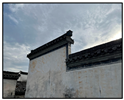 |
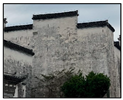 |
 |
 |
| fire seal wall with triple eaves | 3 | 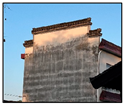 |
 |
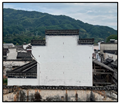 |
 |
| fire seal wall with quintuple eaves | 5 | 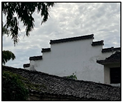 |
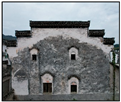 |
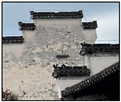 |
 |
However, with the development of modern society, the fire protection function of the Huizhou fire seal wall has gradually weakened, and the original fire protection system and architectural style have been seriously damaged; thus, traditional Huizhou fire seal walls can no longer meet modern fire protection demands.
From the above, the fire prevention situation of traditional Chinese buildings and villages is becoming increasingly serious, and traditional fire prevention technology is gradually dying out. As a traditional fire prevention technology, Huizhou fire seal walls have very important fire prevention research value, but there is little research in related fields. Therefore, it is necessary to further strengthen the role of traditional fire protection technology for traditional village and building conservation. Inspired by this aspect, this study established the following research steps: First, traditional villages in Huizhou were visited, conducted field research on the Huizhou fire seal wall of the traditional Chinese fire protection system, and selected a typical dwelling for mapping. Secondly, the Huizhou fire seal wall was numerically simulated using FDS software (https://pages.nist.gov/fds-smv/downloads.html). The purpose was to compare fire resistance differences and the weak points of fire seal walls with single eaves, triple eaves, and quintuple eaves under the same conditions and analyze the effects of wind speeds, building spacing, and vertical ridge height on the fire resistance of Huizhou fire seal walls under different fire scenarios. Finally, corresponding Huizhou fire seal wall renovation strategies were proposed, which provide a practical reference for the future fire protection renovation of the same type of fire seal walls, and this fundamentally contributes to the protection of traditional villages and buildings in Huizhou.
References
- Romão, X.; Bertolin, C. Risk protection for cultural heritage and historic centres: Current knowledge and further research needs. Int. J. Disaster Risk Reduct. 2022, 67, 102652.
- Xue, L.; Pan, X.; Wang, X. Introduction: Diversity of Cultures, Villages, and Architecture. In Traditional Chinese Villages, 1st ed.; Springer: Singapore, 2021; pp. 1–12.
- Yang, N.; Zang, X.; Chen, C. Inheritance Patterns under Cultural Ecology Theory for the Sustainable Development of Traditional Handicrafts. Sustainability 2022, 14, 4719.
- Chen, J.; Zhang, H.; Cao, Y. Improvement of Traditional Village Protection Infrastructure Management System. In Proceedings of the 5th International Conference on Social Sciences and Economic Development (ICSSED 2020), Xi’an, China, 6–8 March 2020; pp. 368–370.
- Li, Y.; Fan, P.; Liu, Y. What makes better village development in traditional agricultural areas of China? Evidence from long-term observation of typical villages. Habitat Int. 2019, 83, 111–124.
- Chorlton, B.; Gales, J. Fire performance of cultural heritage and contemporary timbers. Eng. Struct. 2019, 201, 109739.
- Ministry of Housing and Urban-Rural Development of the People’s Republic of China. Announcement on the List of Villages to be Included in the Sixth Batch of Chinese Traditional Village List. Available online: https://www.mohurd.gov.cn/gongkai/fdzdgknr/tzgg/202210/20221025768248.html (accessed on 26 October 2022).
- Lu, J.; An, Y.; Zhang, L. Study on the Correlation Between Spatial Distribution of Chinese Traditional Villages and Tourism Development Elements Based on GIS. J. Northeast. Agric. Univ. Soc. Sci. Ed. 2022, 20, 83–96.
- Huang, Y.; Li, E.; Xiao, D. Conservation Key points and management strategies of historic villages: 10 cases in the Guangzhou and Foshan Area, Guangdong Province, China. J. Asian Archit. Build. Eng. 2022, 21, 1320–1331.
- Johnson, M.C.; Kennedy, M.C.; Harrison, S.C.; Churchill, D.; Pass, J.; Fischer, P.W. Effects of post-fire management on dead woody fuel dynamics and stand structure in a severely burned mixed-conifer forest, in northeastern Washington State, USA. For. Ecol. Manag. 2020, 470, 118190.
- Wang, K. Current Situation and Countermeasures of fire safety of cultural relics and ancient buildings. Fire Prot. Ind. 2017, 101–103.
- Zheng, Y. Analysis of the application and technology of the five elements in ancient Chinese buildings. For. Chem. Rev. 2022, 1260–1268.
- Yuan, C.; He, Y.; Feng, Y.; Wang, P. Fire hazards in heritage villages: A case study on Dangjia Village in China. Int. J. Disaster Risk Reduct. 2018, 28, 748–757.
- Wu, Y.; Chen, S.; Wang, D.; Zhang, Q. Fire Risk Assessment of Heritage Villages: A Case Study on Chengkan Village in China. Fire 2023, 6, 47.
- Sivrikaya, F.; Küçük, Ö. Modeling Forest fire risk based on GIS-based analytical hierarchy process and statistical analysis in the Mediterranean region. Ecol. Inf. 2022, 68, 101537.
- Zhang, F.; Shi, L.; Liu, S.; Zhang, C.; Liu, Z. CFD-Based Validation Study on the Fire Prevention Wisdom of Ancient Village Houses in Western Hunan. Fire 2023, 6, 144.
- Ma, J.; Xiao, C. Large-scale fire spread model for traditional Chinese building communities. J. Build. Eng. 2023, 67, 105899.
- Xiaobo, S.; Zhaoyang, C.; Haifeng, L.; Beihua, C.; Feng, Z.; Yunsheng, M.; Xiong, Z.; Shengke, W. Inverse tracing of fire source in a single room based on CFD simulation and deep learning. J. Build. Eng. 2023, 107069, 2352–7102.
- Hashemi, Y. Full-Scale Burn Test of Wooden Three-Story Apartment Building. Fire Sci. Technol. 1997, 17, 78–92.
- Zhang, J.; Wang, Y.; Li, L.; Xu, Q. Thermo-mechanical behavior of dovetail timber joints under fire exposure. Fire Saf. J. 2019, 107, 75–88.
- Schulz, J.; Kent, D.; Crimi, T.; Glockling, J.L.D.; Hull, T.R. A Critical Appraisal of the UK’s Regulatory Regime for Combustible Façades. Fire Technol. 2021, 57, 261–290.
- Okubo, T. Traditional wisdom for disaster mitigation in history of Japanese Architectures and historic cities. J. Cult. Herit. 2016, 20, 715–724.
- Li, J. Investigation of The Passive Energy-saving Technology Alteration of Southern Anhui Traditional Dwellings. J. Hefei Univ. 2015, 25, 69–72.
- Jing, H. A Brief Discussion on Passive Energy Saving Technology in Traditional Dwellings in Southern Anhui: Take Dalikeng Village in Wuyuan, Jiangxi Province, as an Example. Zhejiang Constr. 2014, 31, 49–52.
- Yu, H. Research on Fire Protection Systems in Traditional Dense Residential Blocks in Developed Areas. Master’s Thesis, Southeast University, Jiangsu, China, 2019. (In Chinese).
More
Information
Subjects:
Environmental Sciences
Contributors
MDPI registered users' name will be linked to their SciProfiles pages. To register with us, please refer to https://encyclopedia.pub/register
:
View Times:
685
Revisions:
2 times
(View History)
Update Date:
01 Nov 2023
Notice
You are not a member of the advisory board for this topic. If you want to update advisory board member profile, please contact office@encyclopedia.pub.
OK
Confirm
Only members of the Encyclopedia advisory board for this topic are allowed to note entries. Would you like to become an advisory board member of the Encyclopedia?
Yes
No
${ textCharacter }/${ maxCharacter }
Submit
Cancel
Back
Comments
${ item }
|
More
No more~
There is no comment~
${ textCharacter }/${ maxCharacter }
Submit
Cancel
${ selectedItem.replyTextCharacter }/${ selectedItem.replyMaxCharacter }
Submit
Cancel
Confirm
Are you sure to Delete?
Yes
No




